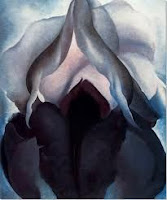IRIS
A low bridge zigzags through a stand of blue irises with fresh green stalks. On a golden Japanese screen, the irises are are perpetually alive, a vivid reminder of both springtime's renewal and absent love. In the painting, the artist alludes to an episode in the tenth-century litterary classics, the Tales of Ise. After a failed love affair, the story's hero, accompanied by a group of friends, leaves the capital for the east in order to start life anew. At a bridge that passes through blooming irises, they compose a poem about nostalgia, love and loss (ARAS, 1:367).
Irises and Zigzag Bridges, by Ogata Korin, painted
screen, ca. 18th century, Japan.
The iris is a genus of about 300 species of flowering plants that for millennia have been prized for their daxxling colors. The number of the iris' stunning natural varieties has been augmented by the extensive use of selective breeding. The flower ranges in color from near black to blue and violet through vermilion, orange, yellow and white, and is often variegated with strongly contrasting hues (Westrich,17). It is this multicolor display of the iris that is responsible for its appellation. Iris, meaning "reainbow" in classical Greek, was the messenger of the Olympian gods. Her emblem was the rainbow of many colors, the bridge by which she traveled between heaven and earth with her divine messages. Analogously, the "iris" is what gives the eye its color.
Lusty mysterious, this iris reflects the deep
reproductive patterns underlying romance and life.
Black Iris, by Georgia O'Keeffe, oil on canvas, 1926.
United States.
Striking not only for its colors, however, but also for its sensual nature, the iris has phallic, sword-shaped leaves surrounding distinctive blossoms consisting of three erect petals and three larger outer petallike sepals. The latter suggest, as in Georgia O'Keeffe's Black Iris, the form and enticement of the feminine genitalia, even if the artist denied that she had such imagery in mind (Wright, 65). While the flower of the iris is not noted for its scent, "essence of violet" perfume is made from orrisroot, derived from the varieties of iris that grow, not from a bulb, but a rhizome, a creeping underground stem (Enc.Brit. 6:384).
Medicinal properties accompany the sensual pleasures of iris. On an Egyptian hieroglyph of an iris carved in stone 3,500 years ago was a list of medicinal plants. The ancient Greeks documented the flower's internal and external uses (Westrich, 9, 12). Traditionally, Japancelebrates an Iris Festival in May, when the flower is publicly displayed and men and women wear bulbs and take baths in which irises have been floating, in order to insure good health and virility (ARAS, 1:367). The iris is also believed to protect against disease and evil spirits (Baird, 85).
The goddess Iris was a messenger of the gods, and
traveled on a rainbow between Olympus and the earth.
Iris was honored by the planting of her flower on the
gravees of women, since it was she who led their souls to
the Elysian Fields (Lehner, 64). The Niobides Painter,
5th century B.C.E., Greece.
The diverse, exquisite hues of "iris," reflected in flower, rainbow and eye, correspond, in the alchemical fantasy, to the "peacock's tail," the brilliant omnes colores that represent the integration of all qualities in the Stone. Just as Iris heralded the approach of the gods, so, psychologically, the show of "many colors" heralds the transcendent self in which the many facets of the personality, once opposing each other, are brought into a unity (CW 14:388ff).
Baird, Merrily C. Symbols of Japan. NY, 2001.
Lehner, Ernst and Johanna Lehner. Folklore and
Symbolism of Flowers, Plants and Trees. NY, 1960.
Westrich, Josh and Ben R. Hager. The Iris:
The Rainbow Flower. NY, 1989.
Wright, Susan. Georgia O'Keeffe: An Eternal Spirit.
NY, 2009.
~Bella

























